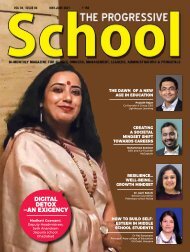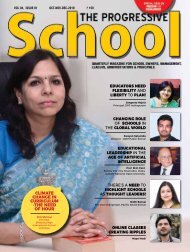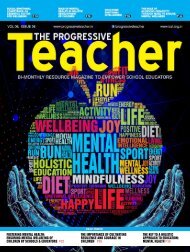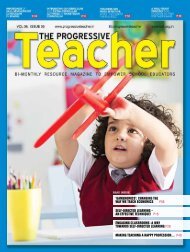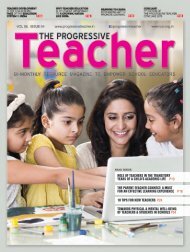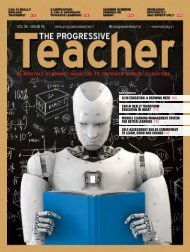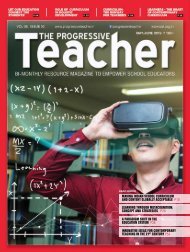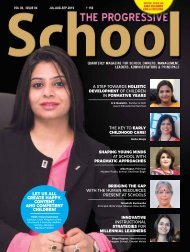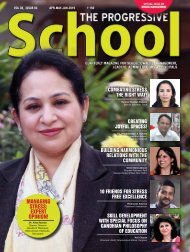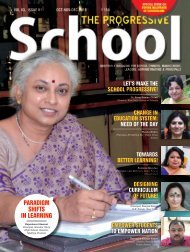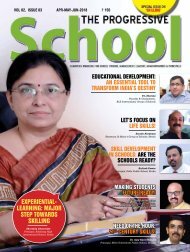The Progressive Teacher Vol 03 Issue 05
This issue of The Progressive Teacher focuses on "Teaching of Social Studies". The magazine provides guidance to the teachers by their peers and school leaders for tackling challenges with innovative ideas.
This issue of The Progressive Teacher focuses on "Teaching of Social Studies". The magazine provides guidance to the teachers by their peers and school leaders for tackling challenges with innovative ideas.
You also want an ePaper? Increase the reach of your titles
YUMPU automatically turns print PDFs into web optimized ePapers that Google loves.
teaching<br />
– Rebecca Alber<br />
I<br />
remember how, as a new<br />
teacher, I would attend<br />
professional development<br />
and feel inundated with new<br />
strategies. (I wanted to get back<br />
to the classroom and try them<br />
all!) After the magic of that day<br />
wore off, I reflected on the many<br />
strategies and would often think,<br />
‘Lots of great stuff, but I’m not<br />
sure it’s worth the time it would<br />
take to implement it all.’<br />
We teachers are always looking<br />
to innovate, so, yes, it’s essential<br />
that we try new things to add to<br />
our pedagogical bag of tricks.<br />
But it’s important to focus on<br />
purpose and intentionality – and<br />
not on quantity. So what really<br />
matters more than ‘always trying<br />
something new’ is the reason<br />
behind why we do what we do.<br />
What Research Says<br />
This leads me to educational<br />
researcher John Hattie, who<br />
wrote Visible Learning for<br />
<strong>Teacher</strong>s: Maximizing Impact<br />
on Learning. Through his<br />
research, one of his goals is to<br />
aid teachers in seeing and better<br />
understanding learning through<br />
the eyes of their students.<br />
Hattie has spent more than<br />
fifteen years researching the<br />
influences on achievement of<br />
K-12 children. His findings linked<br />
student outcomes to several<br />
highly effective classroom<br />
practices. Here I’d like to<br />
highlight five of those practices:<br />
1. <strong>Teacher</strong> Clarity<br />
When a teacher begins a new<br />
unit of study or project with<br />
students, she clarifies the purpose<br />
and learning goals, and provides<br />
explicit criteria on how students<br />
can be successful. It’s ideal to<br />
also present models or examples<br />
to students so they can see what<br />
the end product looks like.<br />
2. Classroom Discussion<br />
<strong>Teacher</strong>s need to frequently step<br />
offstage and facilitate entire<br />
class discussion. This allows<br />
students to learn from each other.<br />
It’s also a great opportunity for<br />
teachers to formatively assess<br />
(through observation) how<br />
well students are grasping new<br />
content and concepts.<br />
3. Feedback<br />
How do learners know they are<br />
moving forward without steady,<br />
consistent feedback? <strong>The</strong>y often<br />
won’t. Along with individual<br />
feedback (written or verbal),<br />
teachers need to provide wholegroup<br />
feedback on patterns they<br />
see in the collective class’ growth<br />
and areas of need. Students also<br />
We teachers are<br />
always looking to<br />
innovate, so, yes, it’s<br />
essential that we try<br />
new things to add<br />
to our pedagogical<br />
bag of tricks. But it’s<br />
important to focus<br />
on purpose and<br />
intentionality – and<br />
not on quantity. So<br />
what really matters<br />
more than ‘always<br />
trying something<br />
new’ is the reason<br />
behind why we do<br />
what we do.<br />
need to be given opportunities to<br />
provide feedback to the teacher<br />
so that she can adjust the<br />
learning process, materials, and<br />
instruction accordingly.<br />
4. Formative Assessments<br />
In order to provide students<br />
with effective and accurate<br />
feedback, teachers need to assess<br />
frequently and routinely where<br />
students are in relation to the<br />
unit of study’s learning goals<br />
or end product (summative<br />
assessment). Hattie recommends<br />
that teachers spend the same<br />
amount of time on formative<br />
evaluation as they do on<br />
summative assessment.<br />
5. Metacognitive<br />
Strategies<br />
Students are given opportunities<br />
to plan and organise, monitor<br />
their own work, direct their<br />
own learning, and to self-reflect<br />
along the way. When we provide<br />
Rebecca Alber is an instructor at<br />
UCLA’s Graduate School of Education,<br />
a literacy specialist, and consulting<br />
editor at Edutopia. She is committed<br />
to equity and access for all students.<br />
She is also passionate about learning<br />
being relevant, engaging, and<br />
revolutionary.<br />
students with time and space to<br />
be aware of their own knowledge<br />
and their own thinking,<br />
student ownership increases.<br />
And research shows that<br />
metacognition can be taught.<br />
Collaborating with<br />
Colleagues<br />
Great teachers are earnest<br />
learners. Spend some time with<br />
a colleague, or two or three,<br />
and talk about what each of<br />
these research-based, best<br />
classroom practices looks like<br />
in the classroom. Discuss each<br />
one in the context of your unique<br />
learning environment: who your<br />
students are, what they need,<br />
what they already know, etc.<br />
How do you bring these five<br />
classroom practices alive<br />
in your classroom? Please<br />
share with us through the<br />
columns of <strong>The</strong> <strong>Progressive</strong><br />
<strong>Teacher</strong>.<br />
20 <strong>The</strong> <strong>Progressive</strong> <strong>Teacher</strong> Nov/Dec 2016




